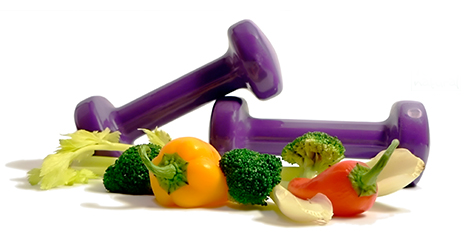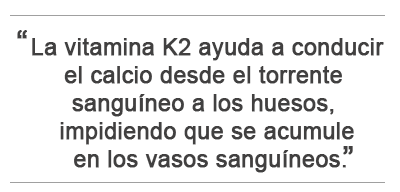Nowadays, we all know that vitamins are essential micronutrients to ensure the vital functions of our body. It is also well known that most of these molecules cannot be directly synthesized by our body and that it is therefore necessary to eat a balanced diet to ensure their daily intake
.
Among the vitamins, perhaps the least known in terms of its functionality is vitamin K. If we were to do a survey, a large number of people would probably answer that it is important for blood clotting, but it is no longer so certain that they know how important it is in other functions of our body, such as the development and maintenance of bone health and cardiovascular health. And if we were to ask how many vitamin K there are, the number of correct answers would probably decrease a lot and the number of “you dont know or dont answer” would increase
.
 The name vitamin K refers to a group of fat-soluble substances, with a similar chemical structure, whose role is essential in blood clotting processes. In fact, they were assigned the letter K after the German word “koagulation”, which indicates this function. This group of vitamins includes Vitamin K1 or phylloquinone, which is found in vegetables and is the one we receive most abundantly with our daily diet, and a group of compounds known under the name of vitamin K2 or menaquinones, among which the most common in nature are menaquinone-4 (MK-4), which is found in small quantities in meat, liver, eggs, and other animal products, and menaquinone-7 (MK-7), which is produced in certain fermented foods such as some cheeses, nattō (a derived from soybeans that are produced in Japan) or by subjecting garbanzos to fermentation
The name vitamin K refers to a group of fat-soluble substances, with a similar chemical structure, whose role is essential in blood clotting processes. In fact, they were assigned the letter K after the German word “koagulation”, which indicates this function. This group of vitamins includes Vitamin K1 or phylloquinone, which is found in vegetables and is the one we receive most abundantly with our daily diet, and a group of compounds known under the name of vitamin K2 or menaquinones, among which the most common in nature are menaquinone-4 (MK-4), which is found in small quantities in meat, liver, eggs, and other animal products, and menaquinone-7 (MK-7), which is produced in certain fermented foods such as some cheeses, nattō (a derived from soybeans that are produced in Japan) or by subjecting garbanzos to fermentation
.
It has been speculated that the body can transform vitamin K1 into K2 through intestinal bacteria, however, current studies question the amount of vitamin K2 that can be obtained through intestinal fermentation because most of the vitamin K1 goes to the liver to fulfill its coagulation regulatory functions and because the transformation into vitamin K2 takes place in the upper part of the intestine, while where there is the highest concentration of bacteria that can produce vitamin K2 is in the lower part of the intestine, the colon, where the bile salts that are necessary for the absorption of vitamin K. This is why the intake of vitamin K2 proves to be very important
.
Benefits of Vitamin K-2 for bone and heart health.
In addition to the regulatory function of blood coagulation processes common to all K vitamins, vitamin K-2 is necessary to activate osteocalcin, a molecule necessary to deposit calcium in bones and which has a synergistic effect with vitamin D, in bone formation and in the prevention of osteoporosis, which is why it is very important both in periods of growth in which bone is formed, and in menopause or when aging when bone tends to lose its structure and there is a greater risk of osteoporosis. A study conducted in the Netherlands, on 181 postmenopausal women, found that the administration of a daily supplement of a mixture of minerals (calcium, magnesium and zinc) with vitamin D and vitamin K2, improved hip bone mineral density by 1.7% more than women who had not received this supplement. The same mixture of minerals and vitamin D, but with vitamin K1, also had a smaller improvement, of 1.3%. And in Japan, another study found that women who ate nattĹŤ (a food rich in vitamin K2 in the form of menaquinone-7) had a lower risk of suffering hip fractures. Other studies have confirmed this benefit of vitamin K and an interesting fact is that obtained from the results of another study, which compared the effects of dietary supplementation with different products containing different types of vitamin K: vitamin K1 (phylloquinone) or vitamin K2 (MK-7) on bone metabolism in menopausal women and which found that the
most favorable changes were obtained with vitamin K2 (MK-7).
It could also be said that vitamin K2 helps carry calcium from the blood stream to the bones, preventing it from accumulating in the blood vessels.
Calcification of blood vessels, especially arteries, is a risk factor for cardiovascular disease, because calcium deposits increase the stiffness and fragility of the vessels and because they are the main mineral component of atheromatous plaques that form from cholesterol that is deposited in the arteries. These atheromatous plaques can block arteries or rupture, leading to blood clots. A study conducted on more than 10,000 people without symptoms of cardiovascular disease, smokers and non-smokers, found that the highest risk of dying from a heart attack in the following five years corresponded to people with the highest amount of calcium present in the vascular system. It was also found that young smokers with high calcium levels are four to nine times more likely to die than non-smokers of a similar age.
 Vitamin K-2 has been demonstrated in different studies that it is capable of reducing the risk of artery calcification and death due to cardiovascular accident, as demonstrated in a large study conducted in Rotterdam that included 4,807 patients and in which it was found that long-term consumption of vitamin K-2 reduced by 50% risk of fatal cardiovascular events. A recent study, with a three-year follow-up of healthy post-menopausal Dutch women, demonstrated that regular consumption of 180 micrograms daily of MK-7 provided protection of bone structures, with improved mineral density and bone strength, both at the level of the vertebrae and the neck of the femur, and reduced the risk of osteoporosis. This same study also found important cardiovascular benefits in the prevention of long-term vascular stiffness and elasticity
Vitamin K-2 has been demonstrated in different studies that it is capable of reducing the risk of artery calcification and death due to cardiovascular accident, as demonstrated in a large study conducted in Rotterdam that included 4,807 patients and in which it was found that long-term consumption of vitamin K-2 reduced by 50% risk of fatal cardiovascular events. A recent study, with a three-year follow-up of healthy post-menopausal Dutch women, demonstrated that regular consumption of 180 micrograms daily of MK-7 provided protection of bone structures, with improved mineral density and bone strength, both at the level of the vertebrae and the neck of the femur, and reduced the risk of osteoporosis. This same study also found important cardiovascular benefits in the prevention of long-term vascular stiffness and elasticity
.
Vitamin K2 in children
During bone development and growth in childhood and adolescence, an adequate supply of vitamin K2 is needed. It has been found that a higher level of vitamin K2 is associated with better bone mass, structure and mineral content of bones and since, according to a study conducted in 2005, most adults and children have a deficient intake of vitamin K in the diet, the possibility of giving children an adequate amount of vitamin K2 to promote better bone structure should be considered. Having a good structure and mineral composition of young bones decreases the risk of suffering from severe osteoporosis in adulthood
.
Why vitamin K-2 in the form of menaquinone-7 (MK-7)?

Several studies carried out by the Vita K research group at the University of Maastricht have studied the bioavailability and bioactivity of food supplements containing various forms of vitamin K and have concluded that MK-7 is much more bioavailable and bioactive than vitamin K1 and vitamin K2 such as MK-4.
Synergy with vitamin D
Although calcium is necessary for bone formation, by itself it cannot be fixed in bones except with the help of vitamin D and vitamin K2. It could be said that vitamin D3 and vitamin K2 work together in this task and several studies have shown that when vitamins K2 and D3 are combined, bone formation increases, the accumulation of osteocalcin in cells and
also increases bone density.
Vitamin K2 (Menaquinone-7) Safety
At normally recommended doses, vitamin K2 has been shown to be very safe for healthy people, however, people taking anticoagulant treatment, although they may have reduced bone quality, should not take vitamin K supplements in any form without medical supervision, as it could interfere with treatments.
- Braam LA1, Knapen MH, Geusens P, Brouns F, Hamulyák K, Gerichhausen MJ, Vermeer C. Vitamin K1 supplementation retards bone loss in postmenopausal women between 50 and 60 years of age. Calcif Tissue Int. 2003 Jul; 73 (1) :21-6
- Gleijnse JM1, Vermeer C, Grobbee DE, Schurgers LJ, Knapen MH, van der Meer IM, Hofman A, Witteman JC. Dietary intake of menaquinone is associated with a reduced risk of coronary heart disease: the Rotterdam Study. J Nutr. 2004 Nov; 134 (11) :3100-5 .
- Kaneki M1, Hodges SJ, Hosoi T, Fujiwara S, Lyons A, Crean SJ, Ishida N, et al. Japanese fermented soybean food as the major determinant of the large geographic difference in circulating levels of vitamin K2: possible implications for hip-fracture risk. Nutrition. 2001 Apr.; 17 (4) :315-21
- Kanellakis S, Moschonis G, Tenta R, Schaafsma A, van den Heuvel EG, Papaioannou N, Lyritis G, Manios Y. Changes in parameters of bone metabolism in postmenopausal women following a 12-month intervention period using dairy products enriched with calcium, vitamin D, and phylloquinone (vitamin K (1)) or menaquinone-7 (vitamin K (2)): the Postmenopausal Health Study II. Calcif Tissue Int. 2012 Apr.; 90 (4) :251-62. doi:10.1007/s00223-012-9571-z. Epub 2012 Mar 4.
- Knapen MH1, Drummen NE, Smit E, Vermeer C, Theuwissen E. Three-year low-dose menaquinone-7 supplementation helps decrease bone loss in healthy postmenopausal women. Osteoporos Int. 2013 Sep; 24 (9) :2499-507. doi:10.1007/s00198-013-2325-6. Epub 2013 Mar 23.
- Prynne CJ1, Thane CW, Prentice A, Wadsworth ME. Intake and sources of phylloquinone (vitamin K (1)) in 4-year-old British children: comparison between 1950 and the 1990s. Public Health Nutr. 2005 Apr.; 8 (2) :171-80 .
- Schurgers, L.J., Vermeer, C. Determination of phylloquinone and menaquinones in food: effect of food matrix on circulating vitamin K concentrations. Haemostasis 30 (2000) 298-307. Ref. & has the 2 graphs beloe, by Schurgers, L.J., Vermeer, C. Differential lipoprotein transport pathways of K-vitamins in healthy subjects. Biochim. Biophys. Act 1570 (2002) 27-32 .
- Shaw LJ, P-rays, Callister TQ, Berman DS. Prognostic value of coronary artery calcium screening in asymptomatic smokers and non-smokers. Eur Heart J. 2006 Apr.; 27 (8) :968-75. Epub 2006 Jan 27.
- van Summeren MJ1, van Coeverden SC, Schurgers LJ, Braam LA, Noirt F, Uiterwaal CS, Kuis W, Vermeer C. Vitamin K status is associated with childhood bone mineral content. Br J Nutr. 2008 Oct; 100 (4) :852-8. doi: 10.1017/S0007114508921760. Epub 2008 Feb 18.
Professor Mª José Alonso Osorio

- Graduated in Pharmacy from the University of Barcelona.
- Graduated in Phytotherapy from the University of Montpellier.
- Specialist in Galenic and Industrial Pharmacy.
- Technical Director and responsible for product development in the Pharmaceutical Industry (1972 to 1985).
- Community pharmacist (from 1985 to 2004 as owner and co-owner, since 2010 as a part-time substitute).
- Professor and tutor in Master and Postgraduate Phytotherapy UB - IL3 (University of Barcelona)
- Collaborating professor in the Masters Degree in Nutrition and Health, UOC (Open University of Catalonia)
- Member of the Governing Board of the Spanish Phytotherapy Society.
- Member of the Scientific Committee of INFITO (Center for Research on Phytotherapy).
- Member of the AEEM (Spanish Association for the Study of Menopause)
- Corresponding academic of the Royal Academy of Pharmacy of Catalonia.
All rights reserved ©. The reproduction, partial or total, of the content in any form is prohibited without the prior written consent of Cien Por Cien Natural SL. If you want to share the information, reproduction is allowed by citing Cien Por Cien Natural SL or using the link on their website. Cien Por Cien Natural SL is not responsible for misuse of the content of the article
.






